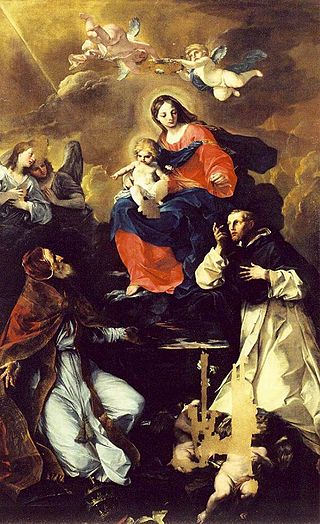Related Research Articles

Giovanni Francesco Barbieri, better known as (il) Guercino, was an Italian Baroque painter and draftsman from Cento in the Emilia region, who was active in Rome and Bologna. The vigorous naturalism of his early manner contrasts with the classical equilibrium of his later works. His many drawings are noted for their luminosity and lively style.

Luca Giordano was an Italian late-Baroque painter and printmaker in etching. Fluent and decorative, he worked successfully in Naples, Rome, Florence, and Venice, before spending a decade in Spain.

The Accademia di San Luca is an Italian academy of artists in Rome. The establishment of the Accademia de i Pittori e Scultori di Roma was approved by papal brief in 1577, and in 1593 Federico Zuccari became its first principe or director; the statutes were ratified in 1607. Other founders included Girolamo Muziano and Pietro Olivieri. The Academy was named for Luke the Evangelist, the patron saint of painters.
The School of Ferrara was a group of painters which flourished in the Duchy of Ferrara during the Renaissance. Ferrara was ruled by the Este family, well known for its patronage of the arts. Patronage was extended with the ascent of Ercole d'Este I in 1470, and the family continued in power till Alfonso II, Ercole's great-grandson, died without an heir in 1597. The duchy was then occupied in succession by Papal and Austrian forces. The school evolved styles of painting that appeared to blend influences from Mantua, Venice, Lombardy, Bologna, and Florence.

The Bolognese School of painting, also known as the School of Bologna, flourished between the 16th and 17th centuries in Bologna, which rivalled Florence and Rome as the center of painting in Italy. Its most important representatives include the Carracci family, including Ludovico Carracci and his two cousins, the brothers Agostino and Annibale Carracci. Later, it included other Baroque painters: Domenichino and Lanfranco, active mostly in Rome, eventually Guercino and Guido Reni, and Accademia degli Incamminati in Bologna, which was run by Lodovico Carracci. Certain artistic conventions, which over time became traditionalist, had been developed in Rome during the first decades of the 16th century. As time passed, some artists sought new approaches to their work that no longer reflected only the Roman manner. The Carracci studio sought innovation or invention, seeking new ways to break away from traditional modes of painting while continuing to look for inspiration from their literary contemporaries; the studio formulated a style that was distinguished from the recognized manners of art in their time. This style was seen as both systematic and imitative, borrowing particular motifs from the past Roman schools of art and innovating a modernistic approach.

The Diocese of Crema is a Latin diocese of the Catholic Church in Lombardy in northern Italy. It has existed since 1579. It is suffragan to the Archdiocese of Milan. The seat of the bishop is the cathedral of Santa Maria Assunta.

Francesco Trevisani was an Italian painter, active in the period called either early Rococo or late Baroque (barochetto).

Domenico Morelli was an Italian painter, who mainly produced historical and religious works. Morelli was immensely influential in the arts of the second half of the 19th century, both as director of the Accademia di Belle Arti in Naples, but also because of his rebelliousness against institutions: traits that flourished into the passionate, often patriotic, Romantic and later Symbolist subjects of his canvases. Morelli was the teacher of Vincenzo Petrocelli, Ulisse Caputo, and Anselmo Gianfanti.

Paolo de Matteis was an Italian painter.

Felice Torelli was an Italian painter of the Baroque style, active mainly in Bologna.

The collections of the Pinacoteca Comunale di Cesena, in Cesena, Italy, contain works by:

Antonio Amorosi was an Italian painter of the late-Baroque, active in Ascoli Piceno and Rome. Amorosi was born in Comunanza, then part of the Papal States. In 1668, he moved to Rome where he was trained by Giuseppe Ghezzi. He painted genre scenes similar to those of the Bamboccianti.

Giuseppe Nicola Nasini was an Italian painter of the Baroque period and active in Rome and Tuscany.

Giuseppe Bottani was an Italian painter active in the Baroque period.

Luigi Sabatelli was an Italian painter of the Neoclassic period; active in Milan, Rome, and Florence.

Lodovico Lipparini was an Italian painter.
La passione di Gesù Cristo is a libretto by Pietro Metastasio which was repeatedly set as an azione sacra or oratorio by many composers of the late baroque, Rococo and early classical period.
Quirino Colombani was an Italian composer, and cellist. He was active in both 17th and 18th centuries.

Antonio Concioli was an Italian painter, mainly depicting sacred subjects in a Neoclassical style.
References
- ↑ Memorie biografiche degli scultori, architetti, pittori ec: nativi di Massa, by marchese Giuseppe Campori, page 208.